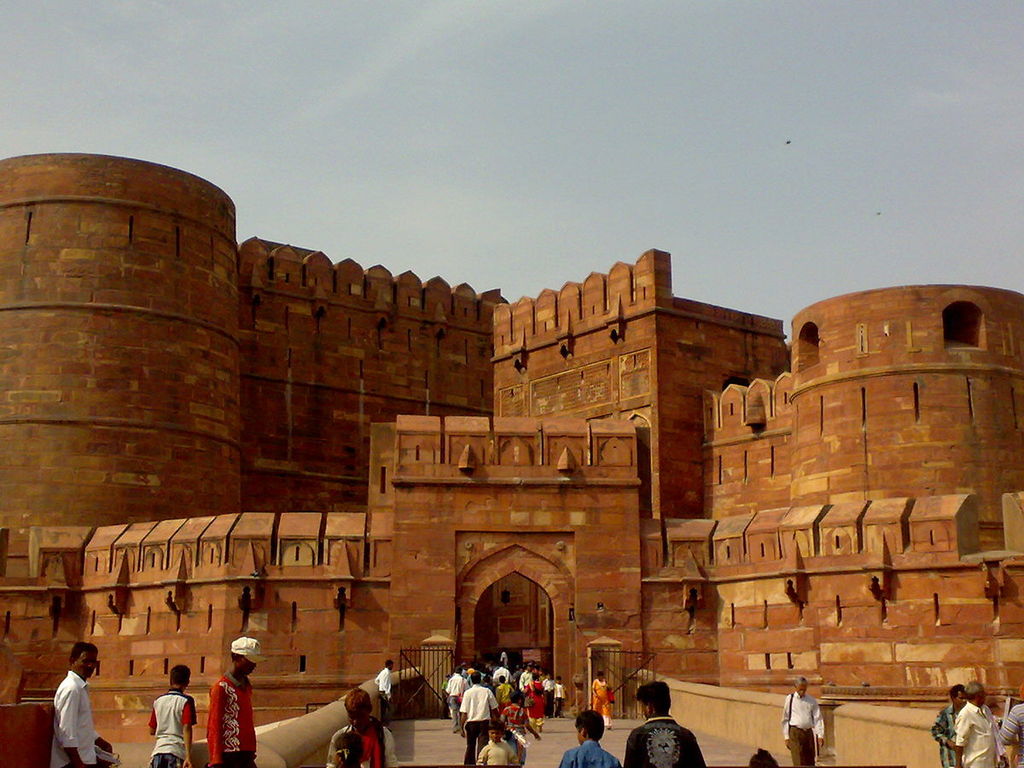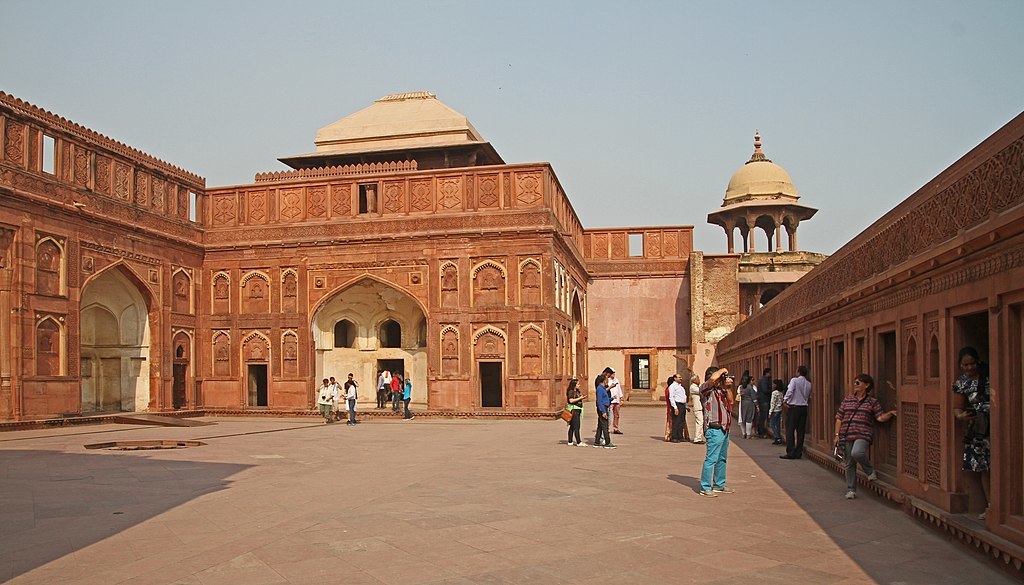Agra Fort often gets overlooked in favor of the Taj Mahal in Agra, but this architectural masterpiece should not be ignored. The massive structure is so huge that it resembles a walled city. While the credit was given to Emperor Akbar for building the fort, he actually built the structure in 1573 over another fort, which some say date back to the 11th century. Some buildings were then built or renovated over the years. It is recognized by historians as a monument that represents the power of the Mughals. The UNESCO World Heritage Site is distinctive because of its unique color, being made from red sandstone transported to Agra from Rajasthan. What’s more, it also features a combination of Hindu and Muslim architectural styles. Here’s our comprehensive guide to Agra Fort, Agra, that will help you navigate your way through this magnificent structure.
Highlights

While it may look like a single structure from the outside, there are actually several buildings inside the fort that are worth checking out. Among those are the following:
Jahangir's Chain of justice
This curious artifact, which is made of gold, was pulled by citizens when they wanted to bring attention to what they believed was injustice. This motion would lead to 60 bells ringing in unison.
Diwan-E-Am
Diwan-E-Am is best known for housing the famous Peacock Throne. At the height of the Mughal empire, this structure was open the general public. While it was the first building to have been made of red stone, it was later shell-plastered to make it look as though it was encased in marble.
Diwan-I-Khas
Diwan-I-Khas is an eye-catching building, made with marble pillars that have carved floral patterns and studded with semi-precious stones.
Jahangir Mahal
The Jahangir Mahal is one of the first buildings your eyes will fall on upon entry. This was named after Emperor Akbar’s son, who ruled the Mughal empire after his father. Strangely enough, the building was not actually built for Jahangir, but to serve as the women’s quarters.
Khas Mahal
Many know of Taj Mahal, the final resting place of Mumtaz Mahal, who was the wife of Emperor Shah Jahan. What many do not know is that she actually had a palace in the Agra Fort. Khas Mahal was built following the styles of Persian and Islamic architecture. Its pillars had floral carvings, with semi-precious stones and gold inlaid in these. Be sure to keep an eye out for the ceiling art, fountains, and lattice works here.
Mammam-E-Shahi
This once served as the summer home of the royalty.
Moti Masjid
Dubbed as the Pearl Mosque, Moti Masjid is one of the most eye-catching buildings in the fort.
Musamman Burj
Musamman Burj was where Shah Jahan was imprisoned by his son, who overthrew him as emperor, and where he spent his last days, overlooking the tomb that he built for his wife, the Taj Mahal.
Nagina Masjid
This was built by Shah Jahan to serve as the private mosque for the ladies of the court.
Shah Jahani Mahal
According to stories, this building, originally made from sandstone, was the first one that Shah Jahan attempted to remodel using marble.
Sheesh Mahal
This structure is perhaps one of the most extravagant structures in the entire fort. Keep an eye out for its water engineering systems, the gorgeous mirror mosaics on the walls, and the intricate carvings.
Travelers tips

IDs
Make sure you have your identification card with you when you go here.
Entrance
While the fort has four gates, only one - the southern gate - is currently open for tourists. This is also where tickets can be purchased. Do note that the prices are different for locals and foreigners.
Behavior
There are certain kinds of behavior that are not allowed in Agra Fort. Eating and smoking, for instance, are prohibited there. You also cannot bring items such as food, weapons, tobacco products, headphones, chargers, and electronic devices. Loud noises are not allowed here. Tourists are also requested to avoid touching the walls and surfaces of the fort.
Bags
While bags are allowed here, it is advised that these are kept small so that inspection won’t take too much time.
Photography
Photography is only allowed if these are taken by the approved guides and photographers. Similarly, visitors are requested to turn their mobile phones off while inside the fort.
Light and sound show
For an additional fee, you can witness the light and sound show held here. There are different schedules for the English and the Hindi shows. The Hindi show is usually scheduled from 7:30pm to 8:30pm, while the English show run from 8:30pm to 9:30pm. The schedule, however, may change occasionally, so be sure to check when you get there.
Best time to visit
Summer can get really intense in Agra, so it is advisable that you time your visit between September and March. Bear in mind, however, since that is the peak season, you are likely to contend with other tourists who are sightseeing. If you want to avoid the crowds, you can head here before sunset, so you can catch sight of the sun going down.
How to get there

By air
Agra has its own airport, which caters to flights going to and from Delhi, Varanasi, and Khajuraho. You can take a cab from there to get to the fort.
By bus
There are buses that pass along the fort.
By train
The nearest station to the fort is Agra Cantonment, otherwise known as Agra Cantt. From there, you can book a cab to take you to the fort.
By cab or rickshaw
There are cabs and rickshaws that you can hail from the city to bring you to the fort.
Tour packages
There are tour companies that include Agra Fort in the itinerary.
How to get tickets (from USD 34.0)

Tickets can be bought on site. Alternatively, you can arrange a tour package that already includes tickets to Agra Fort if you don’t want to contend with long lines.
Agra Fort Entrance Ticket With Guided Tour
Duration: 1 to 2 hours
Agra Fort information

Agra Fort
Address: Agra Fort Rakabgani, Agra 282003 India
Official website: Agra Fort
Department of Tourism: Visit Agra
Opening hours: 6am - 6pm (daily)
Price: 0.50 USD for locals, 7.50 USD for foreign tourists. Entrance is free for children below 15 years old.
News & updates for Agra Fort: Baby feeding room opened in Agra’s Red Fort

From New Delhi: Taj Mahal and Agra Private Tour
Duration: 12.0 hour
History
Get Trip101 in your inbox
Unsubscribe in one click. See our Privacy Policy for more information on how we use your data




















Create an account to